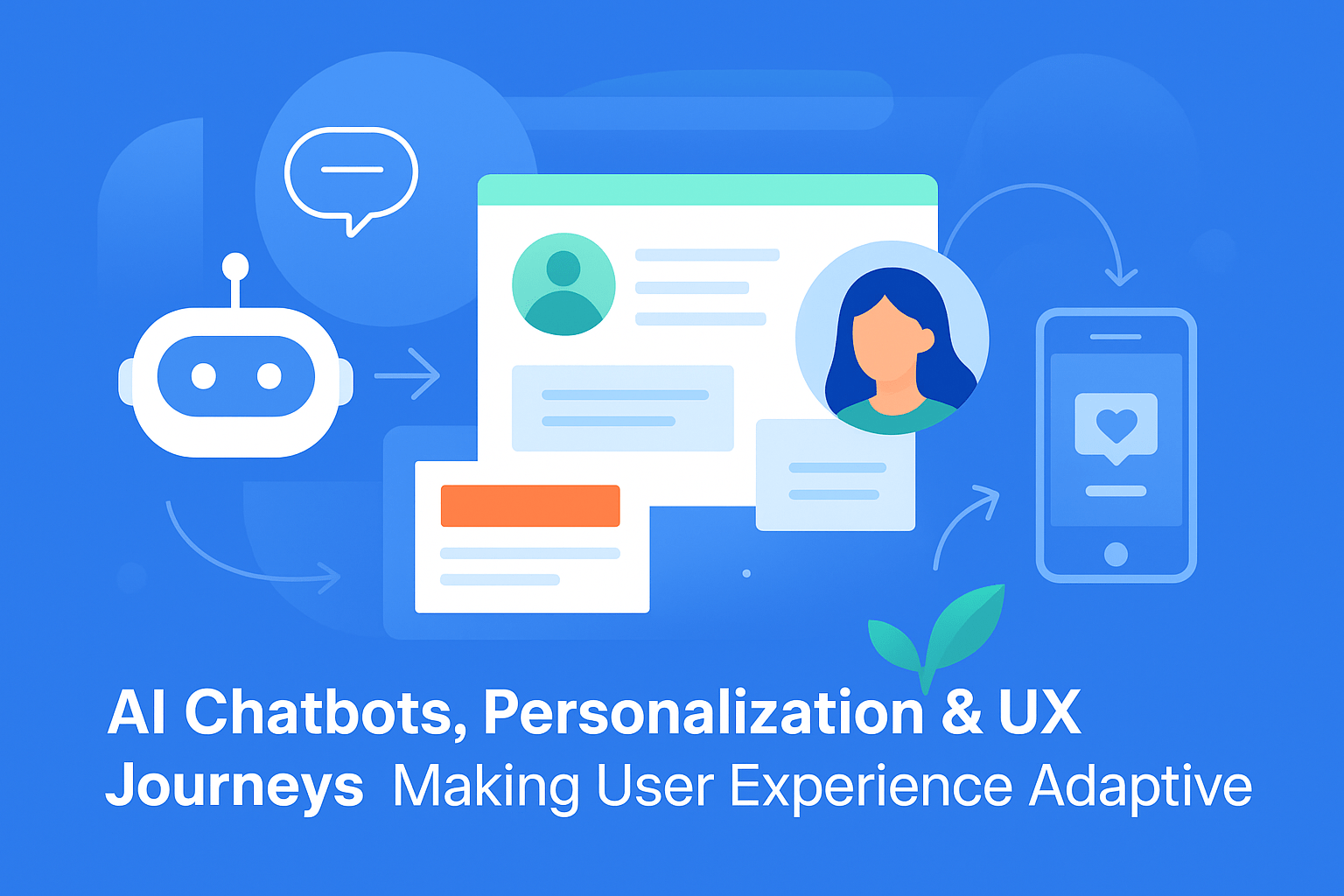AI Chatbots, Personalization & UX Journeys: Making User Experience Adaptive & Smart

The digital experience landscape is evolving rapidly. With the integration of AI chatbots, personalization, and UX journeys, businesses are rethinking how users interact with websites and applications. Traditional static web experiences no longer meet user expectations. Instead, adaptive, smart, and highly personalized experiences are shaping modern engagement.
In this article, we’ll explore how AI chatbots, personalization, and UX journeys are transforming web design, user behavior, and SEO strategies in 2025.
The Rise of AI Chatbots in User Experience
AI chatbots have moved beyond simple query handling. With advancements in natural language processing (NLP) and machine learning (ML), they now play a central role in delivering personalized experiences.
Benefits of AI Chatbots for UX
-
24/7 availability – Chatbots provide instant support without human limitations.
-
Personalized interactions – By leveraging user data, chatbots can suggest tailored content or products.
-
Reduced bounce rates – Conversational engagement keeps users longer on websites.
-
Scalable customer support – Handle thousands of interactions simultaneously.
-
Improved conversion rates – Guiding users smoothly along their UX journey.
AI Chatbots and SEO
Google increasingly values user engagement signals like time-on-site, click-through rate, and interaction depth. AI chatbots enhance these metrics, indirectly improving SEO performance.
Personalization as the Core of UX Journeys
Personalization means tailoring digital experiences to each user’s behavior, preferences, and intent. In modern SEO, personalization ensures that users find exactly what they need, increasing satisfaction and retention.
Levels of Personalization in UX
-
Content Personalization – Blogs, guides, and articles tailored to browsing history.
-
Product Recommendations – AI-driven e-commerce suggestions.
-
Dynamic Landing Pages – Adjusting offers based on geolocation, demographics, or search behavior.
-
Personalized Search Results – AI systems delivering unique SERPs based on intent.
When AI chatbots and personalization combine, UX journeys become smoother and more relevant.
UX Journeys in the Multi-Device Era
Today’s user does not interact with a brand through one channel alone. Instead, they switch between mobile, desktop, voice assistants, and smart devices.
A successful UX journey must:
-
Be consistent across platforms.
-
Offer frictionless navigation.
-
Use data-driven personalization to maintain context from one device to another.
Adaptive UX Journeys in Action
-
A user browsing a product on mobile later gets chatbot support on desktop.
-
A chatbot remembers prior interactions and continues the conversation seamlessly.
-
AI-powered UX adapts design layouts based on device type and accessibility needs.
This approach transforms UX from linear to adaptive and dynamic.
AI Chatbots, Personalization & UX Journeys: The SEO Connection
Search engines like Google prioritize websites that deliver helpful, relevant, and engaging content. AI chatbots, personalization, and UX improvements directly affect these ranking factors.
How They Influence SEO
-
Reduced bounce rates – Personalized journeys prevent users from leaving quickly.
-
Increased dwell time – Engaging chatbots keep users exploring longer.
-
Higher CTRs – Smart personalization boosts click-through rates from SERPs.
-
Improved Core Web Vitals – Adaptive UX enhances site speed and responsiveness.
-
Voice Search Optimization – Chatbots prepare websites for conversational SEO.
By aligning UX journeys with AI-driven personalization, websites rank higher and provide superior user satisfaction.
Best Practices for AI Chatbots and UX Personalization
1. Implement Conversational AI
-
Use NLP chatbots instead of rule-based ones.
-
Train bots with FAQs, transactional queries, and product details.
2. Collect & Use Behavioral Data
-
Track browsing patterns, purchase history, and interaction trends.
-
Feed insights into personalization engines for improved recommendations.
3. Optimize for Mobile-First UX
-
Ensure chatbot widgets are responsive.
-
Deliver lightweight, fast-loading personalized pages.
4. Integrate Chatbots with CRM & Marketing Tools
-
Combine chatbot insights with email campaigns and SEO content strategies.
5. Focus on Accessibility & Inclusivity
-
AI chatbots should support voice commands.
-
Personalization engines should account for accessibility needs.
Challenges in Implementing AI Chatbots and Personalization
Data Privacy & Compliance
Collecting user data for personalization must comply with GDPR, CCPA, and Indian IT laws.
Over-Personalization Risks
Too much personalization may feel intrusive. Balance automation with human empathy.
Technical Complexity
Integrating AI chatbots across multiple platforms requires robust APIs and backend support.
Cost Considerations
Initial chatbot development and personalization systems can be expensive, though ROI is long-term.
Case Studies: AI Chatbots + Personalization in Action
E-Commerce Example
-
An online clothing store integrates an AI chatbot that suggests outfits based on browsing behavior.
-
Personalized UX journeys increase conversion rates by 25%.
Healthcare Example
-
Patients interact with chatbots to book appointments.
-
Personalization ensures follow-up reminders and health content tailored to patient history.
SaaS Example
-
Chatbots guide new users through onboarding.
-
Personalized product tours reduce churn by 30%.
Future of AI Chatbots, Personalization & UX Journeys
By 2030, AI chatbots and personalization engines will be deeply embedded in every digital platform. Key future trends include:
-
Hyper-personalization – Experiences based on real-time behavioral data.
-
Voice-first chatbots – Blending with voice assistants for natural interactions.
-
Predictive UX Journeys – AI anticipates user needs before they act.
-
AI + AR/VR Personalization – Adaptive virtual shopping and immersive experiences.
-
Ethical AI in UX – Stronger focus on fairness, inclusivity, and data transparency.
FAQs on AI Chatbots, Personalization & UX
Q1. Do AI chatbots improve SEO?
Yes. By enhancing user engagement and lowering bounce rates, chatbots indirectly boost SEO rankings.
Q2. Is personalization always good for UX?
When done correctly, yes. Over-personalization without transparency can harm trust.
Q3. How do chatbots support adaptive UX journeys?
Chatbots store user context and make the experience seamless across multiple devices and platforms.
Q4. Are chatbots replacing human customer service?
Not entirely. They complement human agents by handling repetitive queries, allowing humans to focus on complex issues.
Q5. What industries benefit most from AI chatbots and personalization?
E-commerce, healthcare, SaaS, finance, and education see the greatest benefits.
The synergy of AI chatbots, personalization, and UX journeys is reshaping the digital landscape. Businesses that embrace adaptive, smart, and user-focused design will lead the way in SEO rankings, customer satisfaction, and long-term brand growth.
In 2025 and beyond, success will depend not just on keywords but on how effectively websites deliver personalized, interactive, and engaging experiences.
